Shangri-La Diary
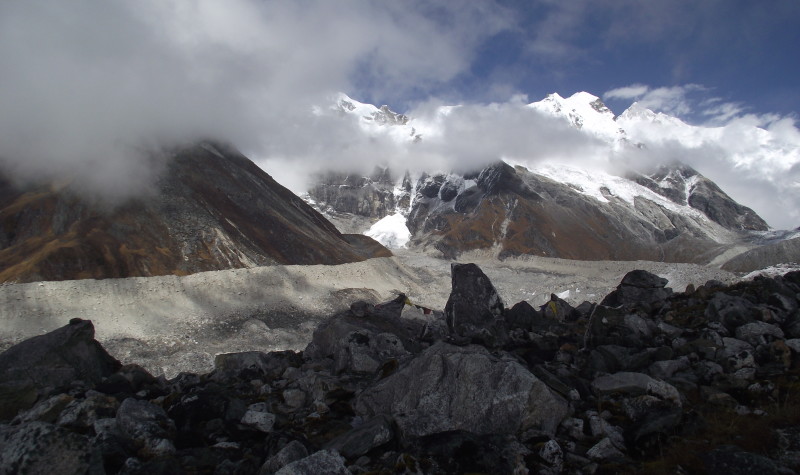
Somewhere, there is a secret garden.
I shall find you there.
Rumi, Persian, 13th Century
Elgin Hotel, Darjeeling, 03 October 2015
I went to the Observation Station at dawn this morning, as recommended by Vijay, but due to mist, could see nothing of the Holy Mountain. The forbidden mountain.
I much prefer the Indian pronunciation of the great mountain range, the one used by our Victorian forebears: Himaa-lya (already plural) rather than the contemporary English Himer-layers.
Walking down the corridors of the Elgin Hotel, squeaking mahogany floors, sepia photographs of the Raj, I am jostled by ghosts. Here is the Prince of Wales in residence in 1926. Insouciant smile; cigarette in hand, almost Noel Coward-like. This one is captioned Johnny and Fannie Cheeseman, Elgin Ball, 1943. Whoever Johnny and Fannie were (for they are no doubt long since dead) they were evidently having a high old time, obligatory cigarettes and tumblers of gin on the go, while war raged across the Earth.
Entering the salon, a uniformed attendant bows. They are all decked out as Sepoys from late Mughal times, complete with daggers. I wonder if the General Manager wears a scimitar. In India, one’s blade is still a status symbol.
From the veranda, I look out over the endless tea plantations in the valley below. Tea time; and my guest, Mr Dorje, is due. I have been assured that he is one of the most experienced mountain guides in the Eastern Himalaya.
Mr Dorje struck me as surprisingly young, and unexpectedly stout. Ethnically Nepalese, but of the Tibetan Buddhist tradition (he said something about a Tibetan grandmother) he is an Indian national and resides – when not in the mountains – in Darjeeling. His people came to Darjeeling and to Sikkim (once an independent kingdom) under the Raj. The British needed tealeaf pluckers.
After elaborate courtesies, I poured the nut coloured, aromatic nectar. (Is it the wonderful beverage or the social rituals it inspires?) Then we got down to business.
I explained how, ever since I spent an evening, years ago, with the illustrious British mountaineer Doug Scott, I had been fascinated by the Holy Mountain: Kanchenjunga to Indians and Nepalese; Kanchendzonga to the Tibetans. The place of the five hidden treasures. The third highest mountain in the world at 8,598 metres.
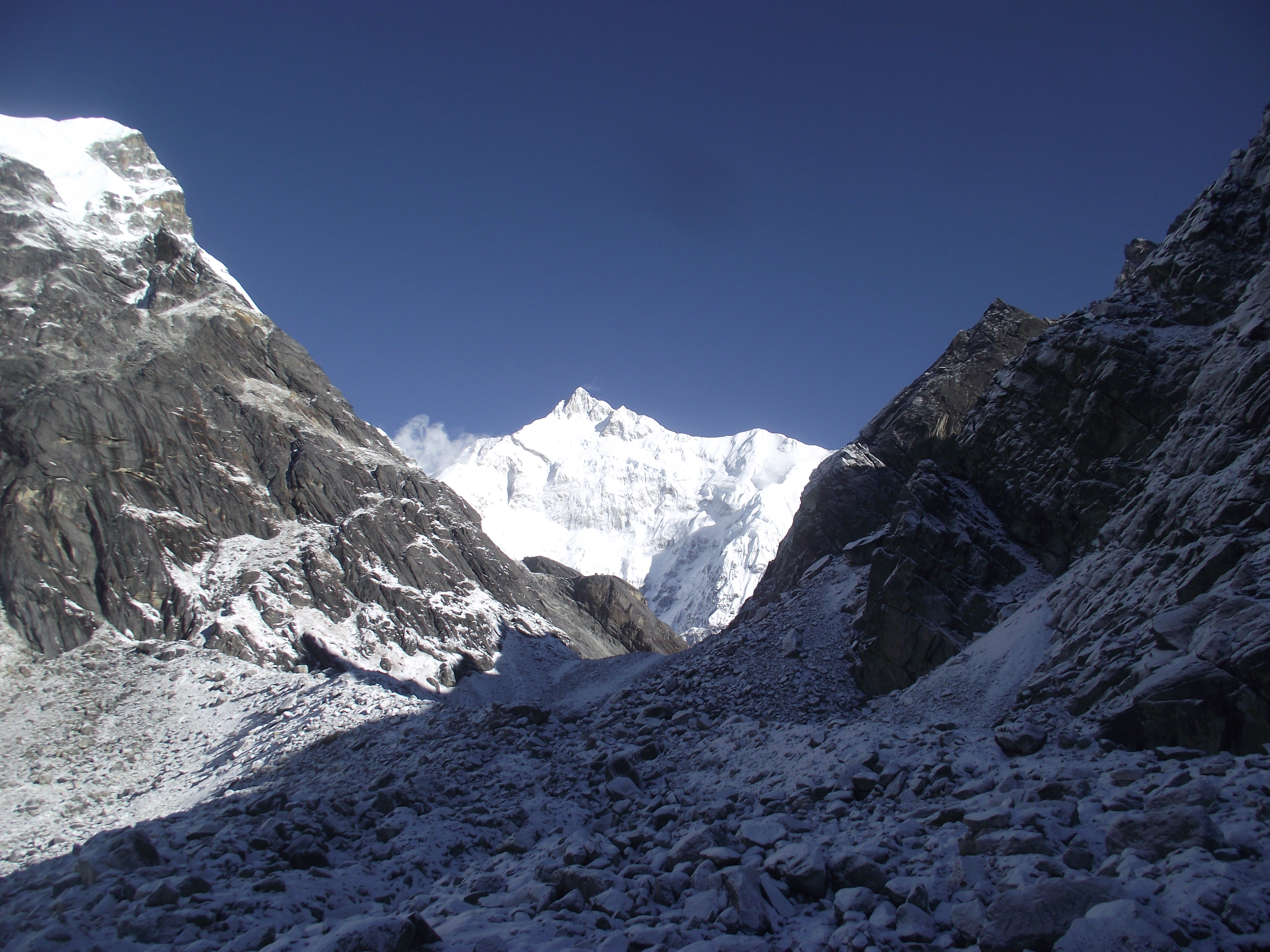
Kanchendzonga range seen from Dzongri at dawn
Unlike Everest, with its perpetual traffic of improbable mountaineers, which is probably being scaled as I write, Kanchenjunga has only been conquered around twenty times – and possibly much less, in the technical sense. Doug Scott revealed that he stopped about fifteen metres below the summit in 1979, out of respect for religious sensibilities.
The Holy Mountain straddles the border of India and Nepal. The border with Chinese-controlled Tibet lies some twenty-five kilometres to the North. The Indians have announced that there will be no more ascents from their territory. And Nepal, currently in political turmoil, has banned all further attempts from theirs. This is a forbidden mountain; yet it dominates the skyline for hundreds of kilometres and inflames feelings of devotion amongst indigenous peoples far and wide.
“I understand, Mr Vector,” Dorje counsels me, “that you wish to get as close as possible to the summit of the Holy Mountain. But I regret this is a most sensitive matter…”
He gives me a nuanced lecture about the political realities of the region. I resist the temptation to say: I know all this.
In the 19th Century, the Great Game was between Britain and Russia in Central Asia (Afghanistan was its epicentre). In the early 21st Century, there is a Great Game between the giants China and India for effective control of the Himalayan passes; but China is the dominant partner. I know that, in their hearts, Indians favour a free Tibet, their spiritual counterpart for more than a millennium; but, in their heads, Indians know that they need to keep the peace with their powerful northern neighbour.
“But, as it happens, Mr Vector Sir, I am leading an exhibition to Goecha-La”. (La means pass in Tibetan). “It leaves in three days’ time. From there, one can ponder the Holy Mountain and its minion peaks with magnificent propinquity. If you would be so gracious as to offer my assistant, Miss Pong, a modest ad valorem, as I believe English gentlemen so call it – cash being graciously preferred – within the next few hours, I could secure your place immediately. Auspiciously, two fine specimens of your fellow countrymen have already committed to this adventure…”
Then it starts to rain. The rain is as torrential as only mountain monsoon rain can be. What will it be like in a tent up there?
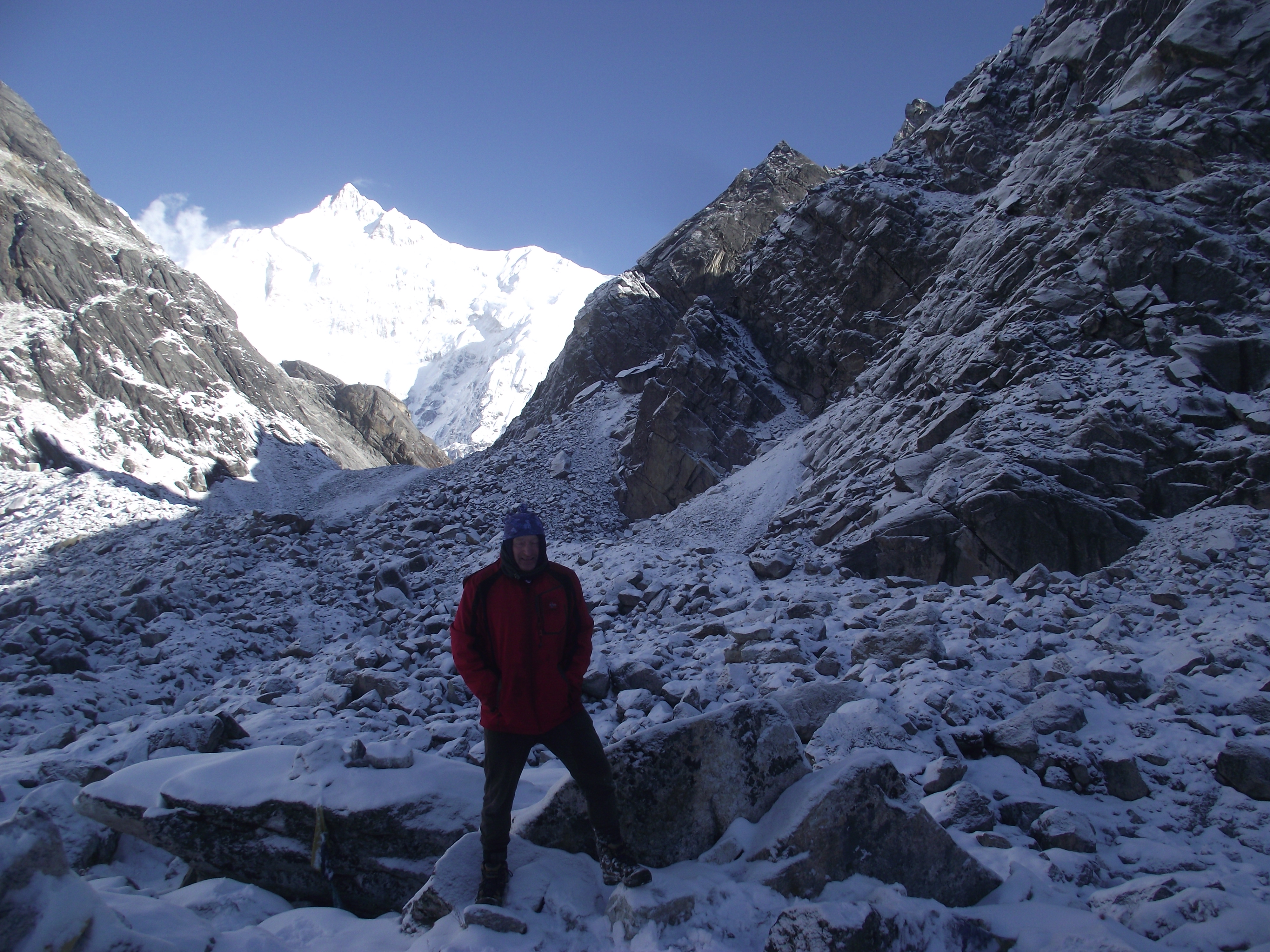
Victor at Goecha-La
Yaksom, West Sikkim, India, 05 October
I have now met my fellow adventurers. Ben is a young English musician, a cellist no less, who graduated from the Royal Academy (?) but who was unable to find a position in a suitable orchestra. Competition is tough these days – in the arts, as in business. He ended up teaching English in Rajasthan. He speaks some Hindi (though unfortunately, no Nepali) and knows a lot about India. I was impressed when he told me: “Anyone who thinks they understand India is deluded”. I think there is a risk he might go native.
Nigel, who recently left the National Trust (or was it English Heritage? – I can’t remember) after some thirty-five years’ service, has come to India to find himself. He wears thick glasses and is a keen birder.
We were invited to climb the hill and to visit the ancient Tibetan monastery of Dubde. A mangy but friendly dog followed us all the way. We entered the shrine room solemnly and some monks appeared, maroon-robed and bare-armed. They began chanting a curious, soft but almost aboriginal dirge. We found out later that they were praying for our safe return from the mountain.
I shall be glad of Ben and Nigel’s company in the days ahead.
Clearing in Jungle, Kanchenjunga National Park, West Sikkim, 06 October
After much bureaucracy at the National Park offices at first light, our caravan was given permission to enter the Restricted Area. One Guide, Dorje; two cooks, three Sherpas, a Horse Man, a Yak Man, five horses, three dzhos (a dzho is a cross between a yak and a cow – a robust but pliant beast). And three Englishman.
We marched for about four hours through sub-tropical forest – temperate jungle – the animals and their masters in the vanguard. Eventually, we made early camp in a forest clearing. A wild pig came snorting round my tent during the night. When I shone my torch in its face it minced away.
Nameless Campsite at around 3800 metres, 07 October
We decamped early after breakfast and followed a rugged path through pine and rhododendron forest. I broke a two hours’ marching silence when the Yak Man and his charges overtook us.
“Do the dzhos have names?” I enquired of Dorje.
He looked at me as if this was some kind of trick question. Then he called out in Nepali to the Yak Man and there was a protracted exchange. At last, he turned back to me.
“They are called Grey, Black and Dark Black”.
I noticed that Grey was wearing brightly coloured tassels in her ears.
Nigel spotted a hoopoe but insisted it was a common one. Its crest became diaphanous for a moment as it swooped past. He tells me this is bird watchers’ paradise.
The Head Cook, Gompo, is a phenomenon. Early morning, he overtook us at the clip of a trotting pony, carrying on his back a huge wicker panier of food – our lunch, in fact, and all the wherewithal to cook it. Diminutive and sinuous, he can only weigh fifty kilos, if that; yet he happily supports a load of twenty-five kilos or more, balanced by a strap around his forehead. Hence his forward-leaning loping gait.
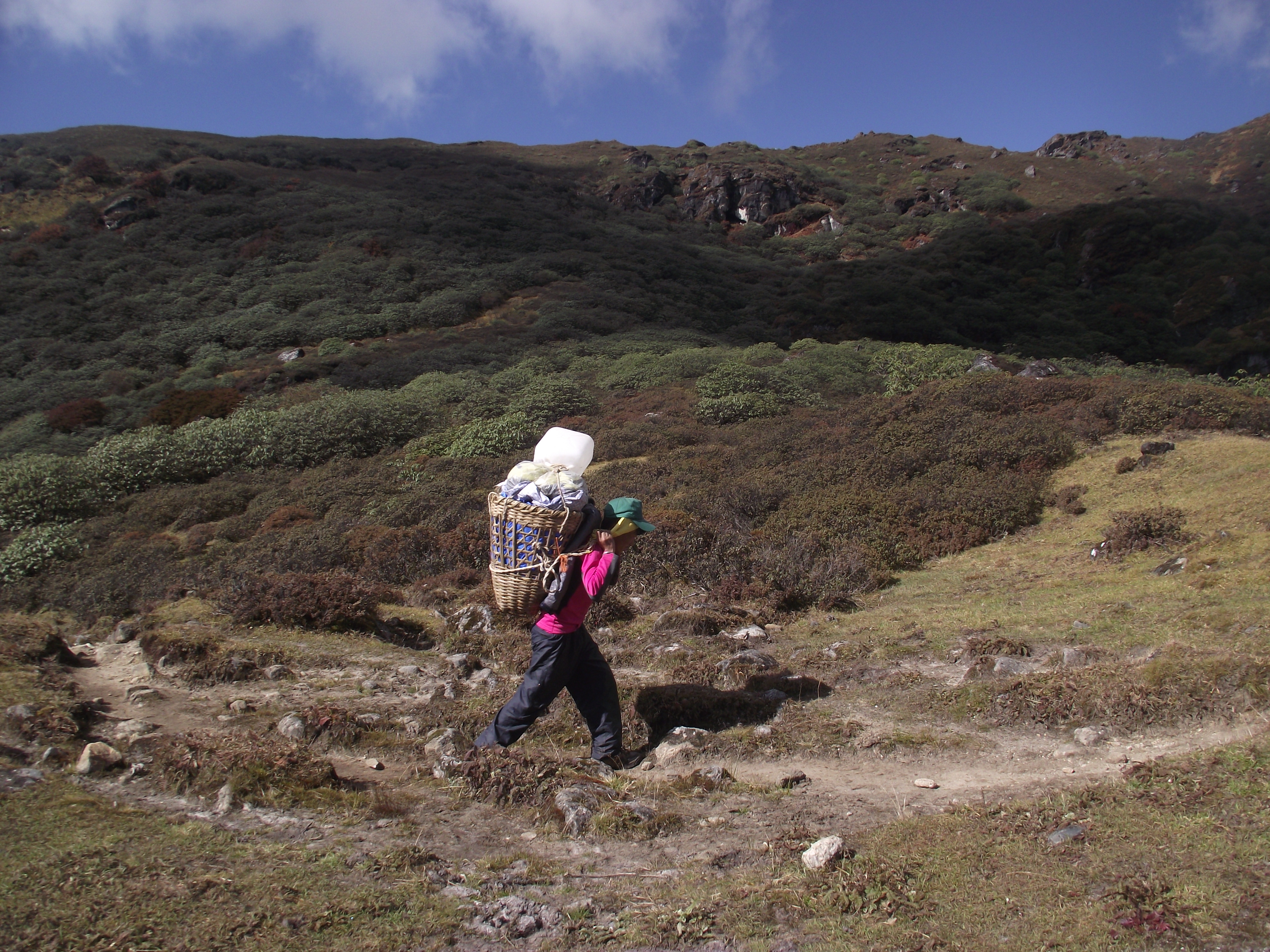
Gompa, the cook
And his cooking is remarkable. Tonight we had mushroom and garlic soup (very sustaining at altitude), Scotch Egg Sikkimese style (boiled eggs clothed in sumptuous aloo (potato) pastry), vegetable curry, pilau rice, razma (soft kidney beans garnished with garlic and chopped tomato), and delicious, succulent chapattis.
That lunch included something I haven’t eaten since my school days – Spam fritters (or luncheon meat to give its posh name). I wolfed it down with freshly baked paratha (buns) and a delicious spicy salad, sitting metres from a waterfall. How he turns out these meals in a tent at altitude is beyond me. The man should be on Masterchef. Mind you, there would be a language problem.
We camped near a raging torrent whose relentless roaring penetrated my dreams.
Campsite on the Plateau called “Tsokha”, 4300 metres, 08 October
I awoke to the sound of what I took to be Nepali curses. It emerged that two horses had wandered during the night. Amazingly, they are normally left untethered overnight and roam within a radius of no more than five hundred metres from the camp. Occasionally however, the male horses get a scent and disappear.
Dorje announced solemnly over breakfast that we would not be able to decamp until the missing horses were found and returned. He suggested that we attempt to scale the nearby Dzongri-La (Dzongri Pass) later that morning, and we agreed. (Nigel couldn’t join us because he said he’d mislaid his glasses).
It took more than three hours along a poorly marked path to reach Dzongri-La: a boulder strewn gap between two mountains which afforded a breath-taking view down towards the forbidden zone of the Kanchenjunga Base Camp. Intermittent mist obscured the view back to our own camp in the valley.
In 1835 a Nepalese army swept through this pass and descended on the Sikkimese capital at what is now Pelling. Sikkim temporarily fell to Nepalese control. Unlettered men have long memories in these parts.
On the downward journey the Horse Man emerged from the mist, with helpers. His expression suggested the two renegade horses were still at large. “If we do not find these horses…” began Dorje. But he did not finish.
Soon after our return to the camp, there was an explosion of emotion. I knew what it was. I unzipped myself from my tent to see the Horse Man and the Yak Man leading the two prodigal horses back into camp. They both had a glint of defiance in their eyes. They looked fulfilled.
Nigel announced, shyly, over dinner that he had found his glasses.
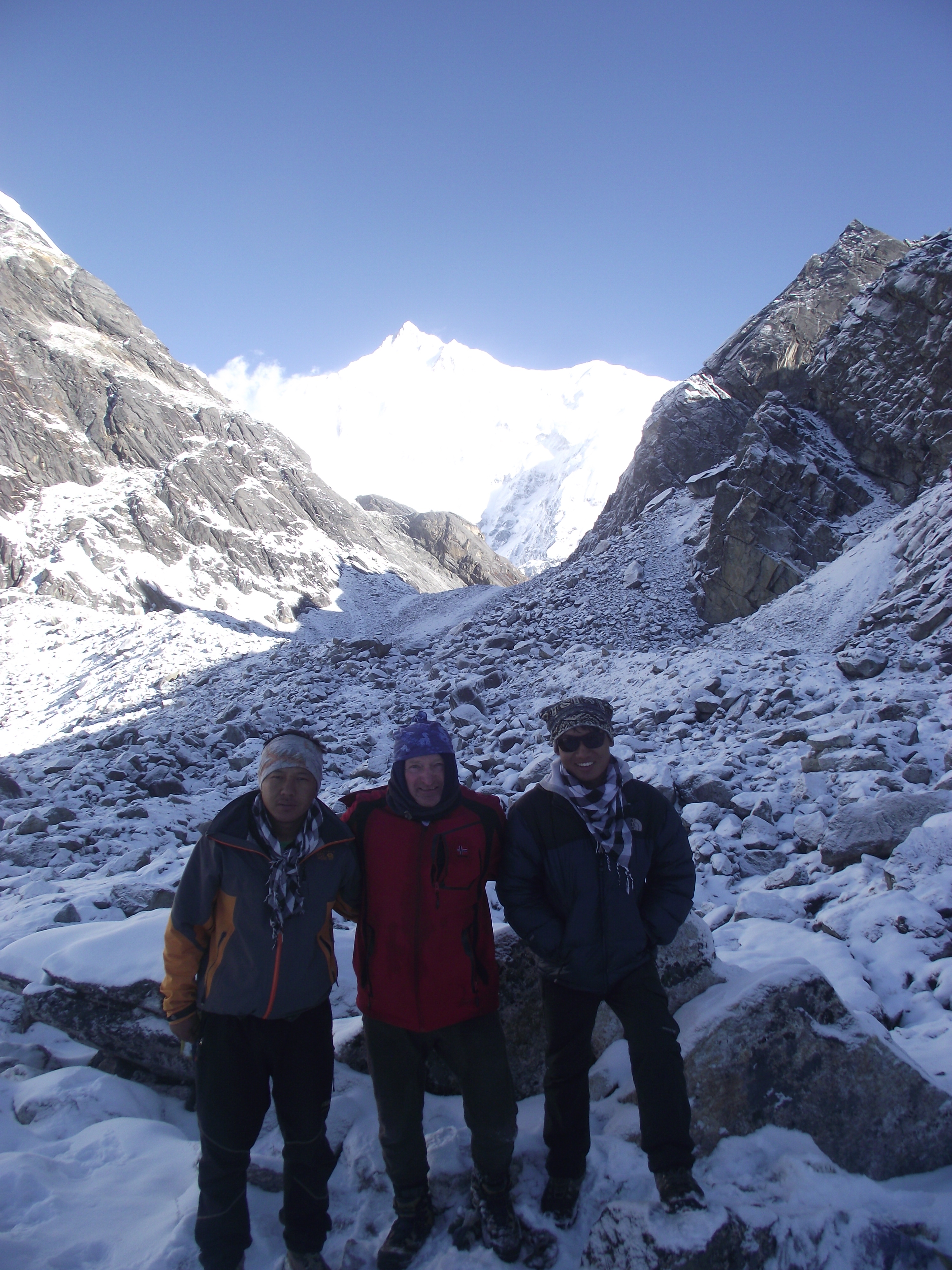
Victor and sherpas
09 October
When I emerged from my tent at first light to answer a call of nature, I saw a shape sitting on a boulder. It was Ben, in lotus position, his arms stretched backwards in an impossible arc.
Lamuney Ridge South, West Sikkim, 4300 metres, 10 October
We have been fortunate with the weather so far; but our luck has now run out. It is snowing hard and the tent, wherein I write, is being rocked by gusts. I tried to read earlier but my hands started to freeze. I am getting back into the sleeping bag (thank God I bought a decent one this time) where I will sleep for nine hours in the posture of a mummy awaiting embalming.
Lamuney Ridge North, 11 October
Dorje announced at dinner that if this poor weather persists we won’t be able to get to the Pass tomorrow. He says he will decide in the wee hours, but that we should be ready for all outcomes!
Campsite “Thangsing”, 4000 metres, 12 October
The Boy brought me tea at 02:30 hours and told me that Dorje had decided we would try for the Pass. My tent was covered with a kind of brittle icing sugar. We left camp at 03:00 hours in utter darkness – not even stars for guidance. I just fixed my head-torch on the feet of the Old Sherpa (who is The Boy’s father) and ordered my legs to follow in his footsteps.
The rugged path gave out as we clambered up a steep scree slope, gaining ground at a sterling pace. I cursed myself for donning too many layers – three fleeces beneath my down jacket – as the sweat poured from my brow. At the first short stop I stripped down. The temperature was about minus ten Celsius, but I still felt hot.
We marched through the void for what seemed an eternity. I was longing for the dawn. We descended a ridge and skirted an invisible lake before another steep ascent through boulders, my lungs now heaving. At length, Dorje announced: “This is the First Observation Point. We shall wait here for dawn”.
Sunrises can be overdone, but this one came as if summoned. First the peak of Mount Pandim took ghostly shape in the Eastern sky. Venus appeared behind, rising rapidly. Then the valley emerged gloomily and the Kanchenjunga range loomed to the North West like a row of silver sharks’ teeth. After the silver came rose-fingered dawn, painting the peaks a pallid pink.
“We shall continue” said Dorje, taking the lead.
We traversed a moraine which finally gave way to the bed of a dried-out lake – a cold gravel desert. Thereafter, we walked for what seemed forever through rock covered in deepening snow. The gradient steepened. Old Sherpa took the lead. “We shall take a shortcut” he murmured. I reflected that if I lost my Nepalese guides I would never be able to retrace the route by which we had come.
As if to spoil my sense of awe, two young, lithe Aussies, led by an almost adolescent Sherpa swept past. “G’day”, they offered.
During the final traverse up to the Pass, I felt I was near my limit. I had to pause every three minutes to recharge my lungs. The lack of oxygen at 5,000 metres was tangible.
Then, almost unexpectedly, we ascended a forty-five-degree boulder field: and there we were – aloft upon the Pass. We beheld the Holy Mountain, her broad Northern shoulder and all her attendant peaks suspended in a luminous pale blue sky. I felt that I could reach my hand and touch the ceiling of the world.
It was minus twenty Celsius. Cameras clicking, I judged this the moment to insert my contact lenses. “You’d better be quick, mate”, said one the Aussies. “Or they’ll freeze”.
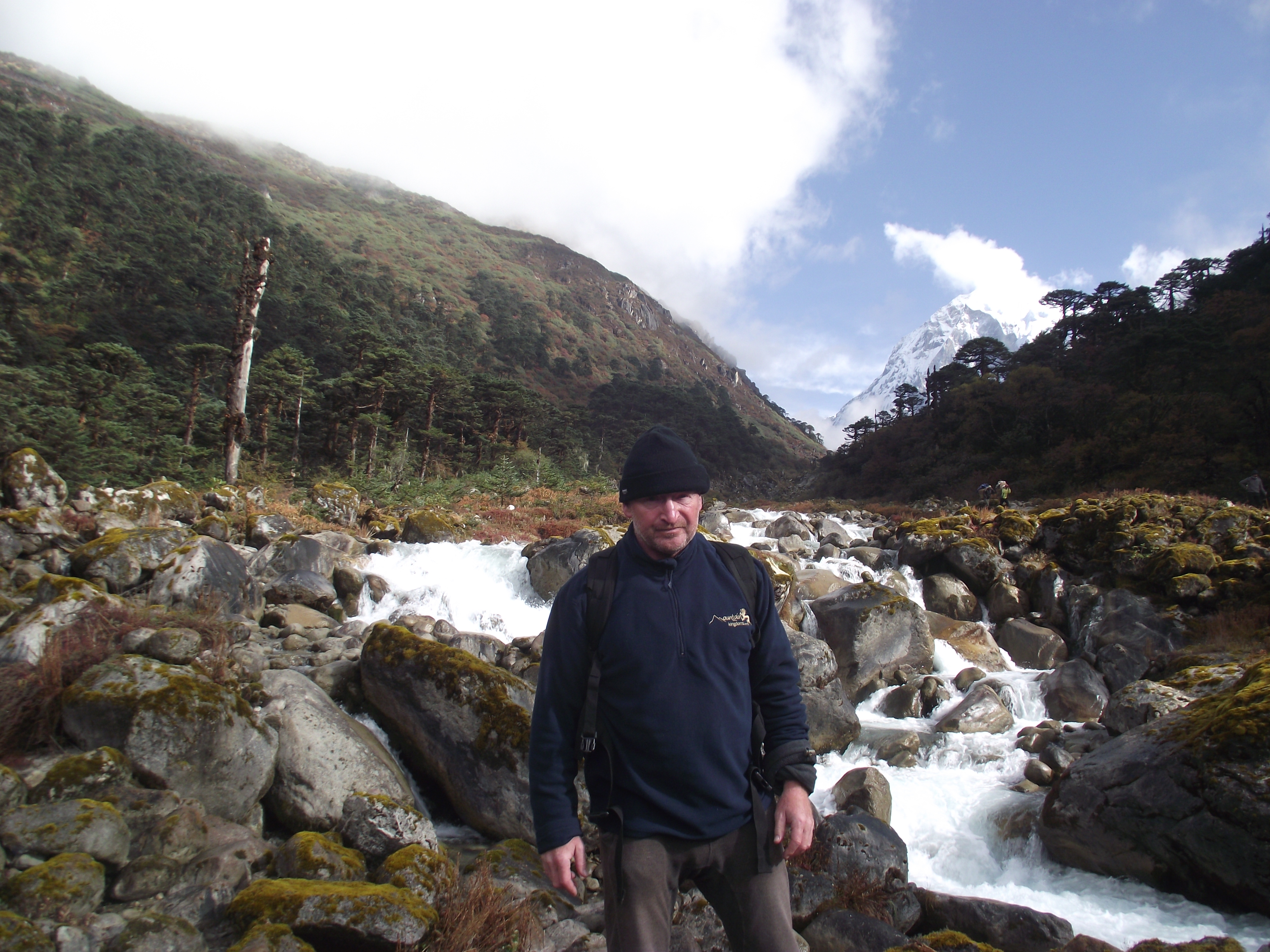
The return journey
Elgin Hotel, Darjeeling, 16 October
I ran into Ben at the Oxford Bookshop this morning. Actually, this illustrious bookshop is well named, and reminded me of Blackwell’s when I was an undergraduate: piles of books on piles of books – a treasure trove of human knowledge, if only you can find what you are looking for.
Ben won’t be joining Dorje and me for the farewell dinner tonight. He says he’s going to a lecture given by a swami. Astral travel, or something weird like that. He’s planning to hang out with some of the guru’s disciples in Kalimpong. I knew this might happen. India does that to some people.
Ben also told me that Nigel left by bus this morning for Arunachal Pradesh. He’s going to live with a hill tribe (the Mong, or something like that) and research a book about the birds of the Eastern Himalaya. I wish him all the best.
I have been overdosing on CNN, BBC World and Bloomberg today, in a desperate attempt to chase the tails of news and markets. Why is it that all that stuff seems so irrelevant above three thousand metres?
I am expecting Dorje for my little farewell dinner, but that’s Vijay approaching with a kind of platter.
Vijay, the sommelier, has delivered me a note on crisp, cream paper, folded into four. This is like a scene from Agatha Christie.
It is from Dorje. He informs me he cannot attend the farewell dinner as he has urgent business in the Kingdom of the Dragon. (Bhutan?). So it’s to be a farewell dinner for one.
Vijay hovers near. I know that he read that note before he delivered it. There are no secrets in India.
He approaches and bends towards my ear, clearly for a confidence. “Mr Dorje” he whispers “is much in demand by the powers that be”. Then he straightens himself and speaks in his normal voice: “A sundowner, Mr Vector, Sir. Perhaps our house gin and tonic?”
I reflect that I have finally shaven off that absurd beard; the scales tell me that I have lost nearly four kilos (despite eating like a horse); and I have kissed the feet of the Holy Mountain.
“Make it a large one, please, Vijay”.
Victor will return with ideas on how to invest in India in next month’s Master Investor Magazine.
Comments (0)